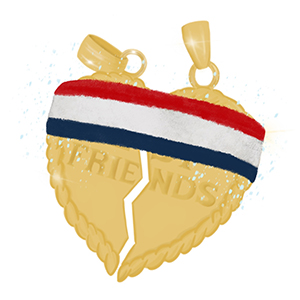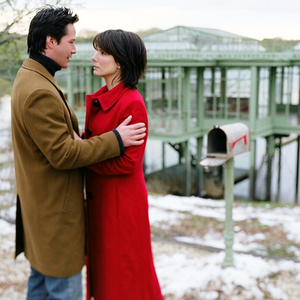
About the Book
-
Author:
- Jaclyn Moriarty
Cover Story: Sixth Doctor
BFF Charm: Eventually
Talky Talk: Music Video
Bonus Factors: The Lakehouse, Transcending Genres
Anti-Bonus Factor: Trilogy
Relationship Status: Sid and Nancy
Cover Story: Sixth Doctor
Well, at least this cover relates to the actual contents of the novel, which is more than I can say about many YA book covers. But man, if Madeleine doesn’t have a touch of the Sixth Doctor about her:

How is possible that she looks more insane than Colin Baker? But that outfit is lifted straight from the first description we get of Madeleine*, so, well played, book cover designers? Unfortunately, it also makes the book look like some frothy, contemporary rom-com beach read, which is super misleading.
*Negative 20 points for making her white, which she’s not.
The Deal:
Fourteen-year-old Madeleine Tully was a spoiled rich girl who frequently ran away from home. Then one day, while hopping on the train from Paris to London, she found her mother running away with her. Now they live in Cambridge, eating tinned beans and watching quiz shows on television, a far cry from their old jet-setting lifestyle with Madeleine’s rich father.
Meanwhile, in the magical kingdom of Cello, Elliot Baranski is an intelligent and talented athlete, well-liked by everyone in his small town of Bonfire. But Elliot doesn’t care about sports games or school friends ever since his father disappeared with a local schoolteacher, the same night his uncle was killed in a Color Attack. In Cello, colors are not merely pigments or visual perceptions. There are also Colors—dangerous, Smoke Monster–like entities that can do anything from altering your emotions to killing you on the spot. Convinced that his father was abducted by the same Purple that killed his uncle, Elliot is determined to find him.
When Madeleine and Elliot discover a crack between their worlds, they strike up a correspondence. Though neither fully understands what the other is saying, they each inadvertently find advice in the others’ words.
BFF Charm: Eventually

Madeleine and Elliot both make it very difficult for me to like them. At first, both seem fine, but then their character flaws take over and they spend much of the novel behaving like the sulky, entitled teens that they both are.
Madeleine is definitely worse—she combines spoiled, selfish brat with Manic Pixie Dream Girl to form a horrible union of abomination. Elliot is better than Madeleine in many respects, but maybe because his selfishness is less overt and abrasive, his “Come to Jesus” moment is a little longer in arriving.
With each other’s help, both finally realize how awful they’ve been. They grow up enough that, by the end of the novel, I was willing to hand out BFF charms to both. Not only are they both pretty rad underneath all their drama, but also Moriarty does a great job of reminding the reader how young Madeleine and Elliot are. Much of their behavior is not borne out of real selfishness so much as childlike naivety. I probably should have cut them some slack earlier on.
Swoonworthy Scale: 2
Both Madeleine and Elliot have love interests—Jack and Kala, respectively—but neither relationship is particularly healthy or interesting. Both happen because Jack and Kala are just kind of there rather than any real level of affection. This story is much more about Madeleine and Elliot discovering themselves and growing up, and neither needs teen romance to do that.
Talky Talk: Music Video
At one point, Jack describes Madeleine as being like a music video:
“You know what she’s like?” he said. “Madeleine, I mean. I’ve been thinking she’s like someone from a music video. You know in music videos, the way they’ll do fast cuts between shots? Like a wide shot of the band playing in a hayloft, then a kid in a school bus, then someone rolling a pen between their hands—that kind of thing. And they keep repeating the same shots in a loop. And they’ve got this one shot—say, the drummer’s a girl and she’s mostly in shadows, but there’s one shot of her looking down and just starting to laugh…and then they cut away, before she gets to the full laugh….That’s the tantalizing bit, and you watch harder and harder, wanting more, and you get the feeling she’s really pretty, but you never see her face or hear her laugh. That’s what Madeleine is like.”
Well, that’s also what this book is like. It is ALL OVER THE PLACE. Not only does the narrative shift back and forth between our world and Cello, but it also changes from Madeleine’s perspective to Jack’s, Elliot’s to the local sheriff. There are also the letters between Madeleine and Elliot, as well as an occasional newspaper column from idiot Princesses Ko and Jupiter of Cello. The overall effect is choppy and disjointed. When layered with all the worldbuilding happening in Cello, the book is difficult to read. I am normally a pretty fast reader, but this took me two to three times longer to get through than my average YA book since I kept having to go back and re-read things.
That’s not to say it’s bad, because the book is clearly very well-written. I loved the letters between Elliot and Madeleine, and once I got the hang of the fantasy world, I was fairly comfortable with the perspective shifting. But there’s a lot going on here—possibly too much.
Bonus Factor: The Lakehouse

Disclaimer: I have never actually seen The Lakehouse, and also, I’m pretty sure it wasn’t very good. I did see the Korean film on which it’s based, Il Mare, which also wasn’t very good, but I do like the basic premise of a magical mailbox. Madeleine and Elliot pass notes through a crack between their worlds—a broken parking meter in our world and a television sculpture in Elliot’s world. As a supporter of all excuses for epistolary exchanges, I particularly enjoyed this plot device.
Bonus Factor: Transcending Genres
Although A Corner of White’s randomness frustrated me, I do appreciate that it’s not a fantasy book or a contemporary book or a “girl book” or a “boy book.” I get really pissed off when people categorically write off entire subcategories of literature because of some preconceived notion about certain genres. (“That’s not my thing.”) Fantasy is not generally “my thing,” but if I never read any, how will I know I don’t like it? How will I read Harry Potter? So I appreciated this book’s refusal to be pigeonholed by genre conventions. I half expected it to turn into a psychological thriller at the end, with Madeleine discovering that Elliot is just a figment of her imagination, a reflection of herself, and she, I don’t know, murdered her father. Obviously that doesn’t happen since it would make the pending sequels problematic, but this book is only predictable in its unpredictability.
Anti-Bonus Factor: Trilogy
Either I did not read the blurb on this book properly, or I promptly forgot everything I’d read, but I did not realize this was going to be a trilogy. So when I got to the end of this book, I was in a RAGE. I spent hours and hours slogging through this confusion, only to have EVERYTHING HAPPEN in the last 20 pages and then BAM. CLIFFHANGER. The lack of resolution is infuriating. Discovering this book was a trilogy felt like the worst thing to happen to me since I got addicted to The Nine Lives of Chloe King, a really terrible show that was on ABC Family for half a season. Absolutely nothing happened for the first nine episodes. Finally, in the last hour of the show, EVERYTHING happened, and then it was canceled. This book was like Chloe King all over again. I guess it’s not as bad because the second and third books will be published eventually, but I won’t be emotionally invested in the characters by then. I feel duped.
Relationship Status: Sid and Nancy
This book and I had a tumultuous affair. There were points when I loved it passionately, and others when I was just aggravated to the point of violence. We’ve always had some serious communication issues in our relationship, but when I found out this book was the first in a trilogy, that really put me over the edge. I guess I should have known—it’s always the way with this type, but I was blinded by the other things happening in our relationship. I finally felt like we were connecting, and then this book was like, “Yeah, I gotta go now. See you in a few months.”
I’m not sure if I will be seeing this book again. Maybe some time apart will be good for us.
FTC Full Disclosure: I received my free review copy from Scholastic. This review was originally posted on Kirkus Reviews in exchange for monetary compensation, which did not affect or influence my opinions. A Corner of White is in stores April 1, 2013.